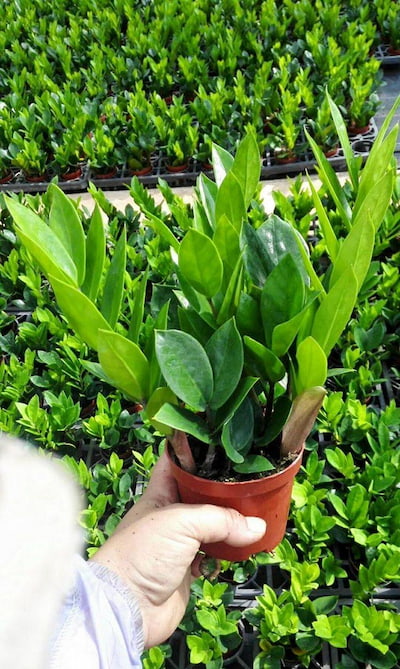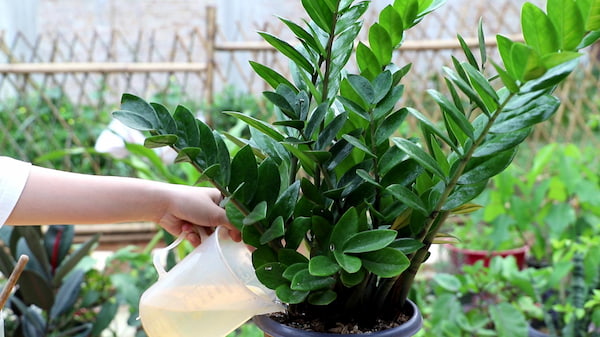ZZ Plant Care Guide: How to Care for ZZ Plant
Written by lisa
Dec 01 2021
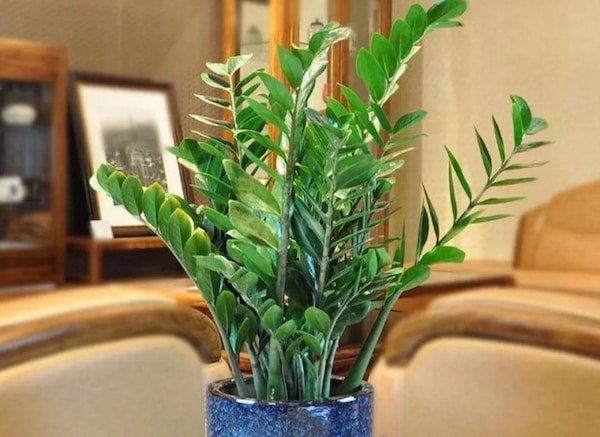
ZZ plant (Zamioculcas Zamiifolia) is a very rare plant with full round thick stems and leaves, which is one of the easiest common house plants to grow and care for. ZZ plants are adaptable to a variety of environments and can live in low light conditions, so it is also one of the best plants for beginners. In Chinese FengShui, ZZ plant plays a role in absorbing the good fortune to be wealthy, so it is also called money plant. Find out how to care for ZZ plant to make it grow better here.
Step1: Pick Leaf Heart
The main purpose of heart picking is to restrain the rapid growth of ZZ Plants. If many shoots are found, remove them in time to prevent them from developing into new shoots and continuing to grow.
Step2: Pick Bud
Many buds will grow from both the dry base and body of the plant. To avoid nutrient depletion, it is important to remove some buds properly. The new bud of ZZ Plants can be checked and further removed after heart picking.
Step3: Pick Leaves
The best ornamental period of ZZ Plants is the germination stage of new leaves. However, if there are too many new leaves, the overall appearance will be affected and the ornamental value will be affected. Therefore, when the new leaves of ZZ Plants are still small and green, it is appropriate to remove some of them.
Step4: Pruning
ZZ Plant has long and steep branches, which can be trimmed according to the pot shape. It can also be trimmed into the middle slightly higher, size varies, such as melon seeds outside the contour, the vision is more beautiful.
When we change the pot for ZZ plant, it is best to change the pot for our ZZ plant in spring. In this way, the survival rate of ZZ plant is relatively high. In fact, it is not suitable to change the pot for our ZZ plant in other seasons.
When we change the pot, it is best to move the whole ZZ plant out, so as to ensure that the soil is still stuck to the root of ZZ plant, which is conducive to the survival of ZZ plant. Then we move the whole ZZ plant to the new pot. Then we need to add some soil properly, preferably the same soil as before. This is conducive to the survival of ZZ plant, do not randomly add some different soil, which will lead to different soil and inhibit the growth of ZZ plant. After that, we need proper compaction of the soil and proper watering of some water, which is conducive to the water absorption of ZZ plant, to ensure that ZZ plant will not be inadaptable due to the change of pot, which we need to know. Finally, after we succeed in changing the POTS, do not take them directly to bask in the sun, you can choose to put them for a few days, and then we can take them to bask in some soft sunshine, which is conducive to the growth of ZZ plant.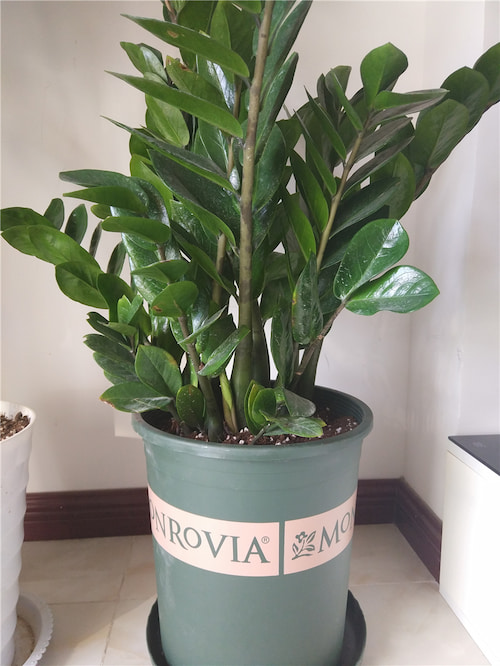
If zz plant root rot is serious, it is best to shake out all the soil, and then soak it in 500 times liquid potassium permanganate or carbendazim solution for 5-10 minutes, and then rinse it again with water, and then air it until the roots are dry, and then plant again.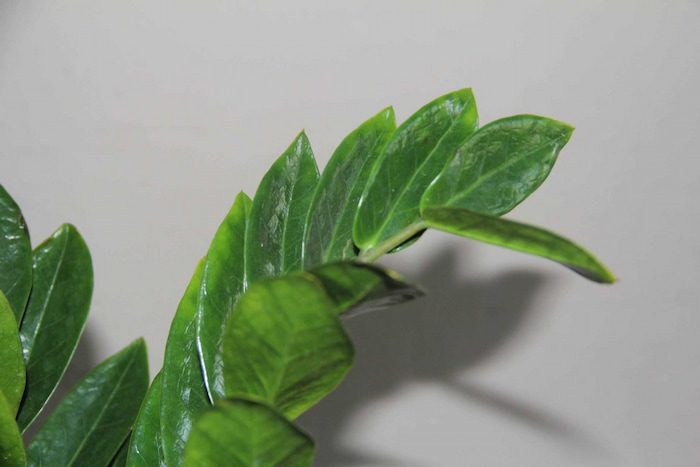
Read Next:
Best 20 Air Purifying House Plants Improve Your Health
Best 15 Indoor Plants for Low Light 2021
ZZ Plant Care Guide: How to Care for ZZ Plant
Zanzibar Gem (ZZ Plant) Profile
How To Propagate ZZ Plant
ZZ Plant Care Key PointsZZ Plant CareZZ Plant Lighting RequirementsZZ Plant Soil CareZZ Plant Watering & Humidity CareZZ Plant Temperature CareZZ Plant Fertilizer CareZZ Plant PruningRepotting ZZ PlantZZ Plant Care - Pests & DiseasesZZ Plant Leaf SpotSclerotinia Root RotScale InsectsZZ Plant Roots rottedZZ Plant FrostbiteZZ Plant BurnsZZ Plant PropagationPropagate ZZ Plant by CuttingsPropagate ZZ Plant by DivisionIs ZZ Plant Toxic?
ZZ Plant Care Key Points
The ZZ Plant is a rare and easy-care houseplant, which is a great indoor plant for beginners. The following sections will provide an in-depth look into ZZ plant care, propagation and other common problems. For your convenience, this article also lists the key information of ZZ plants care briefly.| Botanical/Scientific Name | Zamioculcas Zamiifolia |
| Common Name(s) | ZZ Plant |
| Origin | Eastern Africa |
| Light Care | Bright but avoid direct sun exposure |
| Soil Care | Slightly acidic soil, PH between 6 and 6.5. |
| Temperture Care | Ideal temperatures 20-32℃; Safe between 8℃ and 10℃ in winter |
| Humidty Care | Slightly wet to dry |
| Watering | Water before soil drying, keep slightly wet to dry |
| Pruning Care | Trim leaf heart, bud or leaves |
| Fertilizer Care | 2 to 3 times a month, stop fertilizing in winter |
| Propagation | Cutting propagation or division propagation |
| Repotting | In spring |
ZZ Plant Care
ZZ Plant Lighting Requirements
ZZ plants like light and have strong shading tolerance, so they should grow in a sunny environment with some shade. Avoid direct sunlight to ZZ plants care, especially should avoid the direct sun exposure after rainy in the late spring and early summer or summer afternoon. Otherwise it is easy to cause the burn of ZZ plant young leaves. From the end of spring to the Mid-Autumn, ZZ plants should be placed under shade or indoors with shading of 50-70%, but it should not be too dark. Otherwise, the new tender leaves will be long and thin, the leaves will be yellow and dull, and the spacing of small leaves will be sparse, thus affecting the appearance of the ZZ plants. Additional light should be given to potted ZZ plants that are moved indoors in winter. Keep the soil normal to dry, by which the ZZ plant can remain disease-free for a long time.ZZ Plant Soil Care
Due to the special climatic conditions of the origin of ZZ Plant, it has formed a strong drought resistance. Therefore, the basic requirement of ZZ Plants for cultivation substrate is good permeability. The substrate was mixed with peat, coarse sand or washed cinder and a small amount of garden soil, and its PH value was adjusted to a slightly acidic state between 6 and 6.5. Due to the large tuber, developed root system and long pinnate compound leaves of Z Plant, we should timely observe its growth during the growth period to decide whether to change the pot or soil. Keep the substrate transparent all the time, in order to create a breathable and water-filtered root environment for ZZ Plant. In the plum rain season, check frequently when caring for ZZ plant. Once found that there is too much water in the basin, change the soil for ZZ plant in time.ZZ Plant Watering & Humidity Care
To care for ZZ Plants better, try to keep them in an environment both wet and dry. For plants in the greenhouse or indoor, when the room temperature is above 33℃, should give the ZZ plant water once a day. Because this plant has a strong drought tolerance, it is better to keep the basin soil slightly wet to dry. But occasional excessive watering will not cause ZZ Plant root rot. In winter, we should spray water to the leaf surface and surrounding environment, so that the relative air humidity reaches more than 50%. After late autumn, watering should be reduced, or water spraying instead of watering, to help ZZ Plant to take new leaves safely in winter. In addition, in winter, special attention should be paid to ZZ Plants. The basin soil should not be too wet. It is better to keep it dry.ZZ Plant Temperature Care
The suitable temperature for ZZ Plant care is 20-32℃, no matter pot or ground planting, the average annual temperature change is required to be small. Every summer, when the temperature is above 35℃, ZZ Plant does not grow well. Measures such as covering black net for shading and spraying water to the surrounding environment should be taken to cool it down, so as to create an appropriate space temperature and relatively dry environment for ZZ Plant. It is best to maintain an indoor temperature above 10℃ in winter. If the room temperature is lower than 5℃, ZZ Plant is susceptible to cold damage and its survival is seriously endangered. At the end of autumn and the beginning of winter, when the temperature drops below 8℃, ZZ Plant should be moved to a well-lit room in time, and the temperature should be kept between 8℃ and 10℃ throughout the winter.ZZ Plant Fertilizer Care
ZZ Plants like Fertilizer. In addition to adding proper amount of fertilizer cake or multiple slow-release compound fertilizer in the cultivation substrate, they can be applied 2 to 3 times a month 02.% urea and 0.1% potassium dihydrogen phosphate mixture when growing ZZ plants. They can also be applied 20-10-20 balanced fertilizer, combined with calcium nitrate concentration of 200-250ppm. After late autumn, in order to make it safe for winter, nitrogen fertilizer should be stopped, and 0.3% potassium dihydrogen phosphate solution should be applied continuously for 2-3 times, so as to promote the hardening and enrichment of young young leaf axis and new extract leaves of ZZ Plant. When the temperature drops below 15℃, all forms of fertilization should be stopped, so as not to cause fertilizer damage to the roots under low temperature conditions.ZZ Plant Pruning
The ZZ Plants grows fast and is best trimmed once a year in spring. How to prune the ZZ Plants? Following are ZZ Plant pruning care steps:Step1: Pick Leaf Heart
The main purpose of heart picking is to restrain the rapid growth of ZZ Plants. If many shoots are found, remove them in time to prevent them from developing into new shoots and continuing to grow.
Step2: Pick Bud
Many buds will grow from both the dry base and body of the plant. To avoid nutrient depletion, it is important to remove some buds properly. The new bud of ZZ Plants can be checked and further removed after heart picking.
Step3: Pick Leaves
The best ornamental period of ZZ Plants is the germination stage of new leaves. However, if there are too many new leaves, the overall appearance will be affected and the ornamental value will be affected. Therefore, when the new leaves of ZZ Plants are still small and green, it is appropriate to remove some of them.
Step4: Pruning
ZZ Plant has long and steep branches, which can be trimmed according to the pot shape. It can also be trimmed into the middle slightly higher, size varies, such as melon seeds outside the contour, the vision is more beautiful.
Repotting ZZ Plant
First of all, if we want to repot for ZZ plant, we should not change the pot at random. We need to prepare a larger pot and ensure that the pot is ventilated. It is better to have a hole at the bottom, which is conducive to the survival of ZZ plant after changing the pot.When we change the pot for ZZ plant, it is best to change the pot for our ZZ plant in spring. In this way, the survival rate of ZZ plant is relatively high. In fact, it is not suitable to change the pot for our ZZ plant in other seasons.
When we change the pot, it is best to move the whole ZZ plant out, so as to ensure that the soil is still stuck to the root of ZZ plant, which is conducive to the survival of ZZ plant. Then we move the whole ZZ plant to the new pot. Then we need to add some soil properly, preferably the same soil as before. This is conducive to the survival of ZZ plant, do not randomly add some different soil, which will lead to different soil and inhibit the growth of ZZ plant. After that, we need proper compaction of the soil and proper watering of some water, which is conducive to the water absorption of ZZ plant, to ensure that ZZ plant will not be inadaptable due to the change of pot, which we need to know. Finally, after we succeed in changing the POTS, do not take them directly to bask in the sun, you can choose to put them for a few days, and then we can take them to bask in some soft sunshine, which is conducive to the growth of ZZ plant.

ZZ Plant Care - Pests & Diseases
ZZ Plant Leaf Spot
Brown spot disease occurs mostly on ZZ Plant leaves. The spots are nearly round, grayish brown to yellowish brown, with slightly darker edges. The disease is easy to occur under the conditions of high temperature, high humidity and poor ventilation. After a small number of diseased leaves are found on ZZ plant, they should be removed and destroyed in time. In the early stage of disease, 600 times of 50% carbendazim wettable powder or 500 times of 40% Chlorothalonil suspension should be sprayed on the leaves every 10 days for 3 to 4 times in succession, and the control effect is good. (Find more indoor plants for low light here.)Sclerotinia Root Rot
The disease is known as sclerotinia root rot and sclerotinia seedling blight, which harms the roots of ZZ Plant seedlings and young trees. The affected part was first stained yellow brown to reddish-brown wet rot; The central area of the spot was slightly depressed, and the edge was obvious. The surface of the spot was full of white silk mycelium, radiating and spreading to the surface of the soil. Mycelia produce sclerotia, white at the beginning, then turn yellow, reddish brown to dark brown, serious when the whole plant was killed, causing the ground part of the stem and leaf wilting dead. It invades from the epidermis or wound at the base of the rhizome or petiole of ZZ plant, and after 7 to 8 days of incubation, the disease begins, and mycelia are produced in the disease part for re-infection or multiple infection. Remove the diseased plant in time when found. ZZ plant root rot is closely related to water, pay attention to avoid the rain. After the rain, drainage and ventilation should be strengthened to prevent high humidity. To improve the pH value of soil, appropriate coke marl, grass and wood ash or hydrated lime can be added to ZZ plant culture soil, adjusted to 6.5 to 7.0, and trace elements such as silicon and calcium can be increased. (Read more about Saving Save ZZ Plant From Root Rot.)Scale Insects
In poorly ventilated and poorly lit environment, the leaves of ZZ plant are vulnerable to the stinging and sucking harm of scale insects. A small amount of ZZ plants can be planted at home, and the insects can be removed with transparent tape or wiped with a wet cloth.ZZ Plant Roots rotted
General ZZ plant root rot is caused by overwatering. It is necessary to dump ZZ plant from the pot in time, shake off part of the soil, and place it in a cool place in the shade for 1-2 days before planting it in a new pot. Do not water too often.If zz plant root rot is serious, it is best to shake out all the soil, and then soak it in 500 times liquid potassium permanganate or carbendazim solution for 5-10 minutes, and then rinse it again with water, and then air it until the roots are dry, and then plant again.
ZZ Plant Frostbite
When the winter temperature falls below 5℃, coupled with the moist basin soil, it is easy to cause ZZ plant feathery young leaves to collapse due to cold injury, and even cause tuber rot in serious cases, and it is difficult to restore its vitality. In winter, the indoor temperature should be maintained at least 8℃, and keep the basin soil slightly dry. If a small number of ZZ plants are planted in pots, they can be covered with double-layer plastic bags at night on especially cold days, and then removed after the temperature rises the next day.ZZ Plant Burns
In the hot summer, or attendance fine weather after the long rain, or long time indoor potted ZZ Plant first moved to outdoor, if direct exposure to the sun, it is easy to cause its fat leaf burns, the blade part of its green and white, or the entire leaf burns, late necrosis part black brown. In summer, move ZZ Plant to semi-shade environment in time.
ZZ Plant Propagation
ZZ plant can be propagated by cutting or division.Propagate ZZ Plant by Cuttings
ZZ plant cuttings can have one section of leaf shaft with two leaves or a single section of leaf shaft. In terms of rooting effect, cutting cuttings with leaves on the leaf axis has fast rooting speed, high germination rate and is easier to open into larger tubers. Matrix can be general fine sand, can also be peat, perlite and river sand in a ratio of 3:1:1 mixed matrix. The depth of the cuttings into the soil was 1/3 to 1/2 of the spike length, leaving only the leaves outside the matrix. Spray water permeable in the shade, keep the ambient temperature of 25 ~ 27℃, depending on the degree of dry and wet matrix, spray the leaves 1 ~ 2 times a day, keep the matrix slightly moist. Must not be too wet, otherwise it will cause cutting decay, resulting in zz plant cutting failure. When the cuttings form a certain root system, the middle of the root gradually expands to form spherical small tubers. A small number of tubers can bud and grow new leaves in the same year, but the growth is weak and slow. The tubers grow thick new buds and grow normally in the next year.Propagate ZZ Plant by Division
When the outdoor temperature is above 18℃, remove the large ZZ plant from the pot and shake off most of the original sudden. Break apart the weak tuber binding and apply sulfur powder or grass ash to the wound, and plants separately. Be careful not to plant the ZZ plant too deep. With its tuber tip buried in the soil 1.5 ~ 2 cm. In addition, according to the characteristics of zz plant tuber with latent buds, the large single tuber can be cut into small pieces with 2 to 3 latent buds. After the wound is dried, it can be first buried in the slightly moist sand, and the small tuber cut can grow into independent ZZ plants before pot planting.Is ZZ Plant Toxic?
Yes, ZZ Plant is toxic. ZZ plant produces juice containing calcium oxalate, which is irritating. Its leaf juice sticks to sensitive skin and can cause discomfort for people with sensitive constitution. In fact, many poisonous plants, as long as they are not used for cooking, will not cause any harm to people. Even if many poisonous plants are grown in public places, there is no need to worry too much. In fact, plants have two sides, as long as they are used effectively, it is good for the public environment. ZZ plant toxic substances only reach a certain amount will produce side effects, as long as less touch, do not ingest, do not let the juice touch the wound, will not cause harm to the human body.Read Next:
Best 20 Air Purifying House Plants Improve Your Health
Best 15 Indoor Plants for Low Light 2021
ZZ Plant Care Guide: How to Care for ZZ Plant
Zanzibar Gem (ZZ Plant) Profile
How To Propagate ZZ Plant
Latest Updated
- Benefits of Bugleweed - 7 Science-backed Health Benefits
- Bugleweed Dangers & Side Effects - Is It Poisonous?
- How to Plant Evergreen Trees - What You Should Know
- When to Plant Evergreens - Grow Guide for Evergreen Trees
- 12 Wonderful Evergreen Shrubs for Your Garden
- 12 Popular Evergreen Plants with Pictures for Beginners
- When And How To Prune A Lilac Bush Like a Pro
- How to Grow & Care for Lilac Vine (Hardenbergia Violacea)
- Japanese Lilac Tree (Syringa Reticulata) Care & Propagation Guide
- Shumard Oak Pros and Cons - What to Know
Popular Articles
- Winter maintenance of Antirrhinum Majus
- How to Grow Terminalia Mantaly Tree
- How to Grow and Care for Crossostephium Chinense
- How to grow Antirrhinum Majus in spring
- Peristeria Elata (Dove Orchid) Profile: Info & Care Guide
- Underwatered Snake Plant (Sansevieria Trifasciata) - Signs And How To Fix
- How to Care for Brazilian Jasmine Plant (Mandevilla Sanderi)
- How to Grow & Care for Graptopetalum Purple Delight in Summer
- Rosa Chinensis (China Rose): Plant Growing & Care Tips
- How to Care for Baby Sun Rose (Aptenia Cordifolia)
